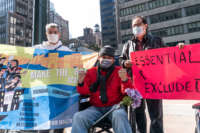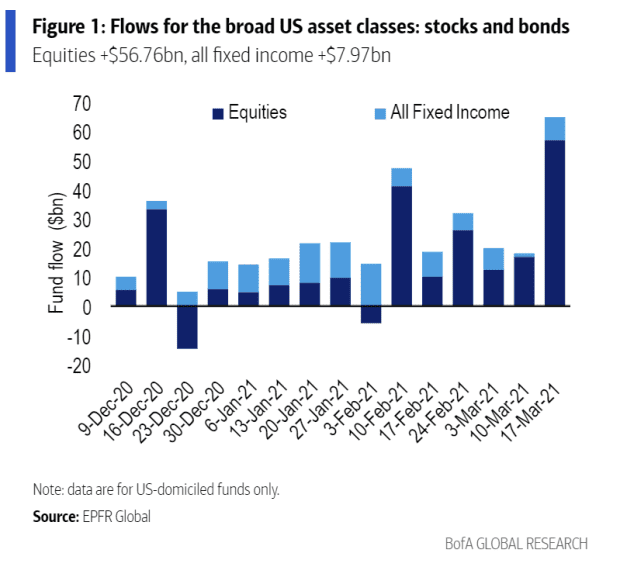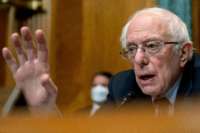AMY GOODMAN: This is Democracy Now! I’m Amy Goodman, with Juan González.
As the United States reports over 79,000 new coronavirus infections Monday and cases continue to rise nationwide even with the vaccines, we turn now to look at pandemic profiteering in the medical system.
A new report by Kaiser Health News reveals some of the nation’s richest hospitals recorded hundreds of millions of dollars in surplus over the past year after accepting federal healthcare bailout grants.
In Texas, the state’s largest nonprofit hospital system, Baylor Scott & White Health, received over $450 million in relief funds, despite laying off 1,200 workers. Baylor is now sitting on a surplus of [$815 million] — appropriate I should cough during a healthcare segment.
The report cited the Mayo Clinic, the University of Pittsburgh Medical Center and NYU Langone Health as other big beneficiaries.
Here in New York, the state’s largest nonprofit health system, Northwell, received $1.2 billion in federal funds from the CARES Act. But Northwell, which is run by a close ally of New York Governor Andrew Cuomo, has faced intense criticism for suing over 2,500 patients last year for failing to pay their medical bills. It only stopped suing for medical debt after a report by the Community Service Society exposed the practice. Meanwhile, The New York Times recently revealed one of Northwell’s facilities, the Lenox Hill Hospital, billed over $3,000 for COVID tests — more than 30 times the typical cost.
We’re joined now by Elisabeth Benjamin, vice president of health initiatives at the Community Service Society of New York, co-founder of Health Care for All New York campaign.
Elisabeth, can you start off by talking about these pandemic profiteers? Why don’t you start off by talking about Northwell and what happened? As patients were in such dire circumstances this year, the hospital sued thousands of them.
ELISABETH BENJAMIN: Yes. So, I think it’s really important to note that two-thirds of all hospitals in America are nonprofit hospitals. In New York state, every single hospital, by law, is a nonprofit 501(c)(3) charity. And we have to remember that the first tenet of medicine is to do no harm.
There’s a lot of talk in our healthcare system about putting patients first and social determinants of health, but this is not doing that. This is not taking care of patients first. Suing patients ruins their lives. It means you have to make decisions between paying your rent or paying a medical bill, putting food on your table or paying a medical bill.
I think what our work has shown — and we’ve looked now at every single hospital in New York state and found that they have collectively sued over 50,000 patients, despite all being charities, and over 5,000 patients during the pandemic — is that there’s a deep problem here with our so-called not-for-profit hospitals. And I think we really need to take stock as a country and say, “Look, either you get to be a charity and you get to raise money and not pay taxes and pull down billions of dollars — for example, $178 billion in CARES Act funding went to hospitals during the pandemic — you can get all that, but you must not sue your patients. Suing your patients hurts them.”
JUAN GONZÁLEZ: Elisabeth, I’m wondering if you could talk a little bit more about this whole issue of the enormous money that the hospitals have made. I did a deep dive into the finances here in New Jersey of the largest hospital chain, RWJBarnabas, and I discovered that they received about $1.2 billion in grants and loans from the federal government, far more than they lost in patient revenues, and during last year as a result of CARES Act funding. At the same time, they were making huge gains in their investment portfolios as a result of the tremendous drive-up in the market. So, they are sitting in far more — it’s almost like the coronavirus became a financial windfall for the hospital, supposed, as you say, nonprofit corporations. The federal government even gave them advanced Medicare reimbursements, which was basically a loan, a zero-interest loan, for these hospitals. And so, how are they able to get away with this?
ELISABETH BENJAMIN: So, I think the issue is, look, we want hospitals, right? We are so grateful to the staff and everybody that works at hospitals for helping us to survive this horrible pandemic. In New York, our nonprofit hospitals got well over $13 billion in CARES Act funding. And, you know, most of the hospitals in New York, I don’t believe, ended up — with the exception of NYU and a few others — with huge surpluses by the end of the year. And perhaps that’s because New York was hit so hard by the pandemic.
My concern is: If we’re going to invest our public dollars and our public good into hospitals, what business do they have in suing patients? And let’s just talk about what happens with these lawsuits. Most patients, you know, are sued, and what happens is there’s a default judgment. If you look at Lenox Hill, for example, the hospital with the $3,000 CARES — corona test, they sue patients — they sue patients for about 1,900 bucks. That’s the median amount that they’re suing for. So, they’re suing patients for not very much in terms of their huge surpluses. They have a nearly $100 million surplus. And they’re suing patients for about $1,900. Altogether, they’re suing patients — they get 34 times more in their annual surplus than they get in what they’re suing for patients over five years. So, what’s going on here? They’re ruining patients’ lives while reaping surpluses in revenue. This is not the way to pay for healthcare, by suing your patients. That’s the problem here.
And so, you know, I think we, as a country, need to really look at how we’re supporting nonprofit hospitals. If we’re going to be investing billions of dollars in them through CARES Act funding, through Medicare, through Medicaid, then I think we have the right to demand certain practices just be dropped. And the first practice that should be dropped is suing low-income patients of color. And I think what’s really important is to understand that LendingTree said that 72% of the people that they surveyed said that medical debt prevents them from achieving their major milestones in life. Forty percent of people of color have medical debt. A hundred and thirty-seven million Americans had medical debt in 2019, before the pandemic.
We really need to have some political action here that says, if you’re a nonprofit hospital, your first tenet is to do no harm. And I think that’s a reasonable expectation. I mean, after all, it was the public outcry that stopped the Humane Society from killing the animals. Hospitals should not be suing their patients. That should be a never event. It should be approved by the CFO and the board of directors if they must sue at all.
JUAN GONZÁLEZ: And, Elisabeth, aren’t most hospitals, because they are nonprofits and charities, required to do indigent care, to a certain degree, and get reimbursed by the state governments for their charity care? How do you reconcile this issue of their having to have some public good as a result of being a charity, and yet they’re continuing to sue as would any for-profit company?
ELISABETH BENJAMIN: I can’t reconcile it. In New York state, we give our hospitals a billion dollars in what’s called indigent care pool funding, or charity care pool funding, and yet, altogether, they’re suing people for, you know, a couple $10 million in each year. It makes no sense.
And when we review the pleadings, because we go to court and we pull all the court case files — for example, Lenox Hill — we found not one offer of financial assistance was actually made or attested to in their court documents. And the documents that they use when they sue people, they use sort of creepy law firms. For example, with Lenox Hill, they’re using a law firm that’s alleged to use process servers that falsify their service of processing. In a federal court action, they’re alleged to basically use a process server that pretends to serve patients, but they really don’t. And then they wonder why all the hospital lawsuits are won based on default. That means that the patient never shows up in court. And if the very, very few that do get their pleadings and are served, when they do show up, you know, they never have lawyers, because they can’t afford it.
What are we doing here as a society? We need to make demands. And, you know, our political leaders need to step up and make demands and say these lawsuits should be never events. We need to have fair and transparent billing. Most patients don’t understand their bills. Consumer Reports did a survey and found that a third of patients pay bills they don’t even think they owe, because they’re so afraid of having an adverse event on their credit report. It’s out of control. And we need to demand more from our nonprofit hospitals.
AMY GOODMAN: Elisabeth, I —
JUAN GONZÁLEZ: Well, you mentioned Lenox Hill Hospital, which is part of the Northwell chain, headed by Michael Dowling, a very close friend and ally of Governor Cuomo. Where is the governor on these issues these days?
ELISABETH BENJAMIN: We have met with the administration several times. And we worked — I co-chaired a committee on indigent care that the governor empaneled a couple years ago. And there were some reforms made on that charity care pool, that indigent care pool. And so that was a great thing that the governor did.
In his State of the State, he said and promised that he would have one unified financial aid form that every single hospital must use in New York state. That has yet to be materialized. And so, we’ve gone to the Legislature and said, “Hey, we need one simple, uniform financial aid form.”
So, every hospital in New York state — there’s over 200 — gets to design their own financial aid form. And if you see one financial aid form, you’ve seen one. In Lenox Hill’s case, you can’t even find the financial aid form on their website. You have to know exactly what to be looking for. And after like four clicks, maybe you’ll make it to the Northwell — the mothership — website, where you might be able to find their financial aid policies. They make it as hard as possible to apply for financial aid. And in all — we’ve never seen a lawsuit where they actually said that they offered financial aid and found that the patient was not eligible. So we need massive reform here.
AMY GOODMAN: Elisabeth, I wanted to ask you about the distinction in hospitals, because people might lump them all together. You’ve got the so-called not-for-profit hospitals, the private hospitals. Then I’m looking at a piece by Politico, “New York’s safety-net hospitals were the front lines of the coronavirus. Now they’re facing ruin.” So, compare them, like Lenox Hill, Northwell, etc., to New York City hospitals that serve the city’s poorest patients facing financial ruin after being on the frontlines.
ELISABETH BENJAMIN: Well, that’s one of the things that we did a big report in the middle of the summer, because the original allocation of the CARES Act funding was based on commercial interest — sorry, commercial insurance practices, your past performance, in terms of getting receipts from commercial carriers. So, you know, NewYork-Presbyterian, originally, and Northwell were getting hundreds and hundreds of millions, and Health + Hospitals, which has a much smaller commercial insured base of business, was getting tiny amounts. That was eventually corrected towards the end of the year, where the big safety-net institutions, they ended up sort of rejiggering the pool. But the idea that the federal government thought it was OK to allocate hospital relief packages based on commercial insurance performance, and not based on Medicaid performance, for example, is crazy making, especially given the fact that the pandemic had such a disparate impact on low-income communities of color, where our beloved essential workers live and work.
AMY GOODMAN: Elisabeth —
ELISABETH BENJAMIN: That was — sorry.
AMY GOODMAN: Keep going.
ELISABETH BENJAMIN: So, that was sorted out, eventually. And I think the allocation, by the time we re-reviewed it in the end of December, early January, it looked like it was sort of right-sized.
But it’s interesting, going back to our indigent care pool that New York state gives out, the billion dollars to support the provision of charity care, that was never allocated as it should have been to the top 25% a safety-net hospitals, of which our public hospitals are all part of, and, in fact, had been spread around like peanut butter to these hospitals, that are so-called charities, that are suing the pants off of patients. So, there’s something deeply wrong. I don’t believe that one charitable hospital who’s suing a patient should be getting any indigent care pool funding, because clearly they aren’t actually following the letter of the law and really getting the financial aid out to the patients that need it.
AMY GOODMAN: Elisabeth, before you go, there’s two critical issues, and we only have a few minutes. One is, we did that first segment on especially undocumented essential workers getting aid. What’s the situation in New York and in California for undocumented people getting healthcare? And then, if you could briefly address the expansion of the Affordable Care Act? I don’t think most people know this.
ELISABETH BENJAMIN: Sure.
AMY GOODMAN: Who has access to Obamacare, depending on their wealth or not wealth?
ELISABETH BENJAMIN: Sure. So, two things. The first thing, on immigrant health, like the essential workers, New York state really fumbled in its budget this year, our leaders. We had put together a package of $20 million — just $20 million — to provide coverage to undocumented immigrants who have COVID. That was unacceptable to our state lawmakers, and that did not pass in our state budget, where they’re raising billions in revenue. So, that’s just a total abdication of leadership by all our lawmakers, and we’re completely upset about that.
In terms of the Affordable Care Act, this is quite extraordinary, what the Biden administration did. They did four things that really help people right now.
Number one, if you’re going — if you’re getting coverage through the marketplace, you are eligible for more financial assistance. So you should immediately go back onto the marketplace and reestimate your tax credits.
Number two, you should — higher-income people are now eligible for financial aid, so if you ever applied for financial assistance through the marketplace and were turned down because of your income, go back. You might be eligible now.
Number three, if you get even one unemployment check in 2021, you can get a zero-premium plan right now that’s super good, a platinum-level plan.
And, number four, they were totally paying for COBRA subsidies between April and September. You get free — the government will pay for your COBRA payments, insurance premium payments. That’s when you get terminated from your job or you lose your job, and you can get the offer of insurance, your job-based insurance. You can get the government to pay for your premiums between April and September 2021.
So, the Biden package, American Rescue Plan, has really done a lot on health coverage for Americans, and we’re super grateful to the administration for that.
AMY GOODMAN: And where can people go to get this information?
ELISABETH BENJAMIN: You can go to, if you’re in a federal, you can go to HealthCare.gov. Or, if you’re state, many states run their own marketplace, and you should go to your own state marketplace and call the call centers. They’re standing by. They can help you. You can also go to a local navigator. That’s a real person. They can — you know, is your champion and can help you sort through all of this.
AMY GOODMAN: Elisabeth Benjamin, we want to thank you for being with us, vice president of health initiatives at the Community Service Society of New York, co-founder of Health Care for All New York campaign.
This is Democracy Now! When we come back, we’ll look at President Biden’s infrastructure plan. Stay with us.
















